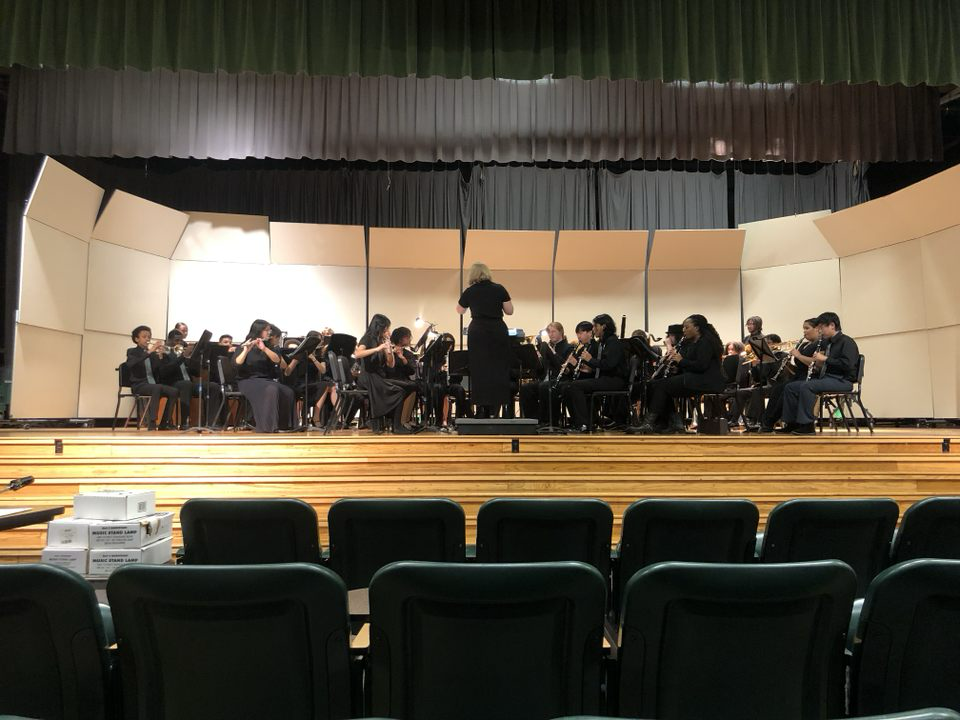Every year, the White Station High School Band puts on its annual spring concert for friends, family and fellow spartans. This year, the concert took place on Tuesday, Mar. 19th at 7:00 pm.
The performance featured three specialty sections: jazz, symphonic, wind ensemble and a percussion ensemble. These groups came together to create a beautiful harmony of music that displayed the hard work, dedication and practice these musicians devote to their craft.
“Concerts show all the different styles of music and how they blend and how music is a universal language that brings different people together,” Griffin Campbell (11) said.
The concert night started off with the symphonic band performing “Phantom Train” by Ed Huckeby. The symphonic section is the only non-audition-based band. It primarily consists of underclassmen and less experienced musicians. Unlike the other sections, the symphonic band is essentially an extension of a beginner band; this band plays easier pieces, ultimately giving its performers an opportunity to focus on the basics and build a strong foundation in music. Over the years, the entry requirements have changed for symphonic band. Before COVID-19, symphonic band required students to already have prior band experience; however, now students are able to join even if they do not have any experience. Since most students in symphonic band had never picked up an instrument until this school year, there were a few bumps throughout the pieces. This proved to be an obstacle for Mia Kitterlin (11), the symphonic band’s only bass clarinet. Kitterlin, a veteran B-flat clarinet player, is a rookie bass clarinet. Although being a bass clarinet does not render Kitterlin with a lot of solos, she plays an important role in the wind section. A bass clarinet bears the responsibility of adding a dimension that creates a full sound in a woodwind performance. As the piece became a little rocky, Kitterlin could only hope that she would fulfill her duty of executing her role.
“Symphonic band is good because if you are inexperienced like I was, you don’t have to learn by yourself,” Kitterlin said. “You learn in class which prepares you for auditioning for the other bands.”
Despite the rocky start to the concert, the jazz band performed shortly after the symphonic band and delivered a good performance. Campbell, a pianist, had a baseline solo in the intro of the Latin song, “Desafinada” by João Gilberto and Stan Getz. Before the concert, Campbell prioritized practicing at least 30 minutes a day and memorizing the chord structure and form to ensure success during the performance. The jazz band also played “Cubano Chant,” “Four on Six” and “Dreamsville.” Campbell recounted a fairly successful night for the band, other than a few hiccups when it came to the rhythms. He commends the band for being able to quickly adjust and appropriately react when mistakes were made.
“As a rhythm section we did good, but we did have an issue with keeping time … mostly I think though we were well balanced throughout the concert,” Campbell said.
The percussion ensemble was composed of seven individuals, including drumline co-captain, Dustin Bobo (11). This group performed “Blue Rondo Ala Turk” by Dave Brubeck. The majority of the audience considered this performance to be solid. In any band, the percussion section is one of the most important pieces of the puzzle. This section specializes in driving the beat and tempo of the music and is often relied on by the other sections for the appropriate time to play. This night however, towards the end of the piece, some percussionists lost their place in the piece, causing them to stop playing. As this happened, experienced players like Bobo were able to not let this lapse in playing get to them and ruin the piece. They held their composure and executed their roles to the best of their abilities.
“Going forward, like for next time, I want to kind of sit down with some of the people who were struggling and help them so the performance can be a little more rock solid,” Bobo said.
Even in light of the mistakes that were made at the concert, the overall performance can be described as successful. Though the performance did not go down without a hitch, the band was able to find success in their growth as musicians and individuals. Each band showcase serves as a learning experience for the group. The band can now reflect on what went well to make sure that going forward they nurture those skills and make these positive habits a constant in every other performance. Like any other profession, being a musician has its highs and lows. One not-so-perfect performance is not defining of the collective, it is a testament to the growth and learning in a band.
“I think this concert was really good for our accountability,” Kitterlin said. “To go on stage and make mistakes can be really embarrassing, but feeling that embarrassment can push you to learn from those mistakes so the next time you play, it will be better.”




































